It is normal to be alarmed by the machines and tubes near your baby, and wires on their skin. Don’t be shy - ask a nearby nurse or doctor about their purpose (and click here to view this module's glossary section to learn more).
- Isolettes
- Premature infants are often kept inside
 isolettes, which are plastic incubators that help to prevent changes in your newborn's body temperature. They also have arm holes that allow for minimal disturbance to this inside environment.
isolettes, which are plastic incubators that help to prevent changes in your newborn's body temperature. They also have arm holes that allow for minimal disturbance to this inside environment.
- Premature infants are often kept inside
- Intravenous Lines (IVs)
- These are small tubes, or catheters, placed inside of a vein.
- IVs are commonly used in the NICU to deliver fluids and medications directly into your baby’s blood.
- Monitors
- Machines are used to monitor your baby’s heart rate, breathing rate, and the amount of oxygen in their blood.
- CPAP/BiPAP machine
- These are ways of supporting your newborns breathing, without the use of a breathing tube (endotracheal tube).
- CPAP stands for Continuous Positive Airway Pressure
- This machine helps to keep your child’s airway open so they can breathe more easily on their own
- This can be delivered using a mask, and can be used at home, as well as in the NICU.
- Room air may be delivered through the CPAP machine, or more oxygen can be added as needed.
- BiPAP stands for Bilevel Positive Airway Pressure, and it provides two levels of positive pressure to support breathing
- The lower, background pressure acts like a CPAP machine would during ‘out’ breaths, to help hold your baby’s airway open.
- Then, during an ‘in’ breath, a
higher pressure is used to further support the breath
- BiPAP may use room air, or more oxygen can be added as needed.
- Ventilator
- A ventilator may be used if your baby isunable to breathe on their own. This machine will help to inflate their lungs so they can get enough oxygen to supply their body. A tube will be used, which extends down their airway, from their mouth down to their lungs.
- Feeding tubes
- A fine gavage tube is a feeding tube that goes from your baby’s nose (nasogastric (NG)) or mouth (orogastric (OG)) down into their stomach. This may be used when they are unable to feed by mouth, but are still ready to digest food in their stomach and intestines.
Reference:
AbbVie Corporation (Ed.). (2015). Preemie Parent Handbook (4th ed.). Canada: AbbVie Corportation.
Photo 3: (Staff Sgt. Bennie J. Davis III, U.S. Air Force photo, Public Domain)
